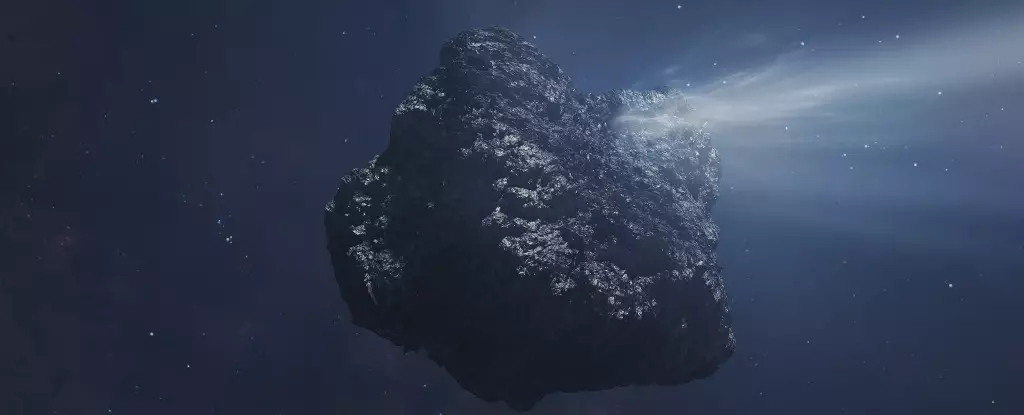In a moment that feels almost apocalyptic, astronomers have identified an enormous ice giant—Comet C/2014 UN271, also known as Bernardinelli-Bernstein—barreling toward the inner Solar System. This colossal entity stretches a staggering 137 kilometers (85 miles) in diameter, dwarfing the infamous asteroid that led to the dinosaurs’ extinction by nearly 14 times. While scientific community celebrates this celestial marvel, alarm bells ring for those of us who are acutely aware of the metaphorical baggage such discoveries often carry. The devastating potential of cosmic events can precipitate a sense of dread, especially when confronting the fact that this massive comet is currently voyaging towards us at breakneck speed.
However, before one succumbs entirely to doomsday scenarios, it’s imperative to recognize that C/2014 UN271 will not breach the safe perimeters of our planet’s orbit. It’s projected to swing by within the orbit of Saturn on January 29, 2031. Nevertheless, the excitement among astronomers comes with a tinge of anxiety—a delightful fear experienced by those who peer into the void but understand how fragile our existence truly is.
Unveiling the Chemical Symphony
Recent observations employing the Atacama Large Millimeter/submillimeter Array (ALMA) have revealed fascinating behavioral patterns of this icy giant, which was caught in the act of “outgassing” carbon monoxide from its surface. The initial findings on March 8, 2024, indicated two powerful jets spewing gases into the cosmos, giving astronomers tantalizing clues about the comet’s interior dynamics. This is where the scientific intrigue blossoms: “These measurements grant us insights into the operational mechanics of this enormous, icy world,” noted Nathan Roth from American University and NASA Goddard Space Flight Center. Yet, what emerges from such scientific sentiments may also breed existential musings about our very place in the universe.
As if underscoring the comet’s volatile nature, the subsequent observation just nine days later unveiled a solitary jet, raising questions and curiosity in equal measure. The fleeting nature of these jets serves as a reminder that even celestial bodies are in a constant state of flux. This variability could suggest that rather than remaining a passive cosmic visitor, Comet C/2014 UN271 embodies a dynamic force—one that can be both captivating and disconcerting.
The Oort Cloud and Its Enigmatic Residents
C/2014 UN271 is not merely an isolated wonder; it comes from the Oort Cloud, an expansive region teeming with icy bodies that represent the remnants of our Solar System’s formation. This narrative complicates our understanding of what lies beyond our familiar bounds. While the comet boasts the largest measured size from the Cloud, it exists amidst an array of other celestial entities whose own behaviors and characteristics remain under scrutiny.
This inherently challenges our understanding of cosmic scales and the histories they have endured. Should we be delighted or disturbed that these relatively hidden worlds can, at any moment, become key players in the Solar System’s dynamic? It’s terrifyingly beautiful to think about how human existence is governed by codes and rhythms established eons before our arrival—codes that even the most advanced technologies cannot fully comprehend.
Illuminating the Unknown
As UN271 edges closer to our cosmic neighborhood, the scientific community is exhilarated yet apprehensive about what lies ahead. It is a spectacle to be observed, albeit from a distance; the comet’s trajectory ensures that no naked-eye view will grace our evenings. Telescopes will become our glasses to the celestial evocation ahead—a bittersweet reminder that, while we have the tools to witness such grand phenomena, we may never truly touch them.
In the age of misinformation, the comet prompts a reckoning. How do we reconcile awe with fear? How do we balance wonder with responsibility as we learn to navigate the unpredictable, wild openness of the universe? C/2014 UN271’s approach not only serves as a lesson from the cosmos but also a wake-up call for those willing to listen—a reminder of our tenuous existence on a blue dot hurtling through the abyss. The behemoth from the Oort Cloud is not just a curiosity but a catalyst for deep reflection on humanity’s fragile connection with the universe.

Leave a Reply